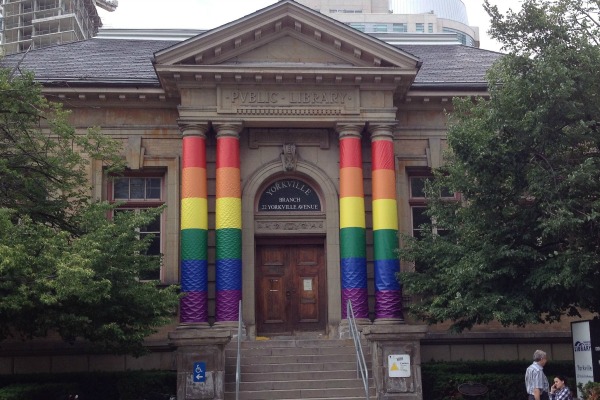Your Pride Is Our Pride
by Dr. Denise O'Neil Green | June 17, 2014 10:00 AM
Last year I experienced Pride Toronto for the first time. It was festive and the U.S. Supreme Court had ruled against DOMA – the Defense Against Marriage Act, a case that had intimate connections to Toronto.
 This year World Pride 2014 is coming to Toronto, and you can see signs of preparation all around. Businesses have transformed their displays to show PRIDE colors and even my institution, Ryerson University, which is literally located in the centre of all the action, is displaying its PRIDE with street banners and ads of its own.
This year World Pride 2014 is coming to Toronto, and you can see signs of preparation all around. Businesses have transformed their displays to show PRIDE colors and even my institution, Ryerson University, which is literally located in the centre of all the action, is displaying its PRIDE with street banners and ads of its own.
In a few days the city will be the place of PRIDE for so many. It’s scheduled from June 20 – June 29. Ryerson’s Positive Space Committee has done an excellent job in connecting, preparing, and engaging the LGBTQ Toronto community to support and join in the celebration. So from this standpoint, it’s all good!
Nonetheless, after WORLD PRIDE has come and gone, there remains work that still needs to be done. In particular, making learning environments and workplaces bully-free zones and places where inclusive language is the norm. Jonah Hill’s sincere apology spoke volumes to this issue.
While allies of the LGBTQ community, such as Johan Hill, are working towards inclusion. I’ve learned that the LGBTQ community has its own challenges with being inclusive. The intersections of sexual orientation, gender identity and expression, race, Aboriginal status, class, and so forth dictate different levels of privilege, inclusion, and marginalization.
An example of this was demonstrated last month at an Empire Club of Toronto event, titled “What Will World Pride Mean to Toronto”. While the moderator was a racialized women, the four invited speakers did not represent the various diverse experiences of this community. Not knowing what went on behind the scenes (i.e. who was invited, accepted, or declined), it can be a challenge to even pull together a diverse panel of speakers if we are not intentional. Either intentionally or unintentionally we can be exclusive when the aim is to advance inclusion.
 For the last Soup and Substance for 2013-2014, the topic was “Your Pride is My Pride: Experiences of the LGBTT2SIQQA Community @Ryerson”. In planning this, we had to be very intentional to include voices that could speak to particular experiences: Transgender, 2-Spirited, Bi-Sexual, Lesbian, Racialized, Gay, etc. It’s not always easy; however, it goes a long way to ensure connections.
For the last Soup and Substance for 2013-2014, the topic was “Your Pride is My Pride: Experiences of the LGBTT2SIQQA Community @Ryerson”. In planning this, we had to be very intentional to include voices that could speak to particular experiences: Transgender, 2-Spirited, Bi-Sexual, Lesbian, Racialized, Gay, etc. It’s not always easy; however, it goes a long way to ensure connections.
So, for my colleagues who operate in these spaces, please remember something that I’ve learned from my colleague Heather Willis: “Be intentionally inclusive vs. unintentionally exclusive”.
I Want to Hear from You:
How does your organization promote inclusion versus exclusion?
I look forward to your responses below*, and I'd love your input.
*Note: You will need to register for an Institutional Diversity Blog account in order to comment, but you can get started right away by clicking here, or visiting our FAQ page for more help. Also, check out this video on "Registering for an Account on The Institutional Diversity Blog".
Source URL: https://institutionaldiversityblog.com/your-pride-is-our-pride/